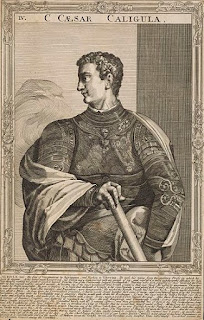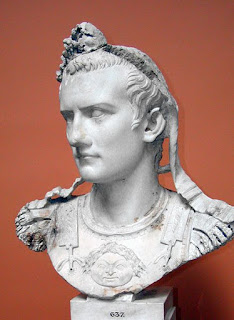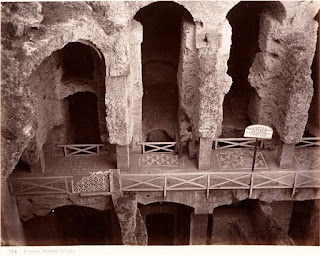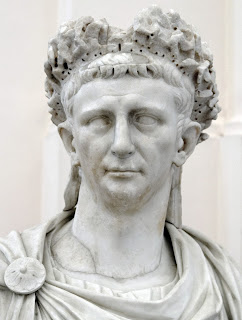Controversial emperor killed by Praetorian Guard
 |
| A line engraving depicting Caligula from the Wellcome Collection gallery |
His killers were officers of the Praetorian Guard who confronted him in an underground corridor at the imperial palace, where he had been hosting the Palatine Games, an entertainment event comprising sport and dramatic plays.
According to one account, Caligula was stabbed 30 times in a deliberate act of symbolism, that being the number of knife wounds some believe were inflicted on Julius Caesar, his great-great-grandfather after whom he was named, when he was murdered in 44BC, although the number of blows Caesar suffered is disputed.
Most accounts agree that the chief plotter in Caligula’s murder, and the first to draw blood, was Cassius Chaerea, an officer Caligula was said to have frequently taunted for his weak, effeminate voice.
The motives behind the assassination were much more than one aggrieved officer wishing to avenge a personal slight.
 |
| This bronze bust of Caligula is displayed in the Metropolitan Museum of New York |
The young Gaius adored his father, who would take him on military campaigns from the age of three, fitting him out with a uniform and a small pair of boots - caligula in Latin - the name Germanicus’s soldiers adopted as a nickname for the little boy, which was to stick with him for life.
Tiberius, who killed or imprisoned most of Caligula’s family and whom Caligula blamed for the death of his father during a mission to Rome’s eastern provinces, was deeply disliked by the Roman public, with whom Caligula won favour immediately by releasing citizens unjustly imprisoned by Tiberius and scrapping a number of unpopular taxes.
He also staged chariot races, boxing matches, plays and gladiator shows for the amusement of himself and his citizens.
 |
| This bust can be found in the Ny Carlsberg Glypotek museum in Copenhagen |
Tormented by crippling headaches, Caligula distracted himself by brazenly indulged his sexual proclivities, committing incest with his sisters and sleeping with other men's wives, bragging about it to them afterwards. He began to flaunt his power in the most cruel ways, eliminating his political rivals and forcing parents to watch the executions of their sons.
He is said to have killed for mere amusement. Once, at a games event over which he was presiding, it is alleged that he ordered his guards to throw an entire section of the audience into the arena to be eaten by lions because there were no prisoners left and he was bored.
Caligula caused more outrage with his declaration that he was a living God, spending a fortune on a bridge between his palace and the Temple of Jupiter and demanded that a statue of himself be erected in the Temple of Jerusalem for his worship.
In his insanity, he was said to have promised to make his horse, Incitatus, a consul, and actually did appoint him a priest.
 |
| The remains of Caligula's Bridge on the Palatine Hill in Rome |
Caligula’s wife and daughter were also killed and for a while the military were divided between those who sought the reinstatement of the Roman Republic and those who favoured a continuing imperial monarchy. Eventually, the latter faction prevailed, with Caligula’s uncle, Claudius, who is said to have hidden behind a curtain while his nephew was being murdered, announced as Caligula’s successor.
 |
| The ruins of the Palace of Augustus on the Palatine Hill, seen from the Roman Forum |
From the time of Augustus, who ruled from 27 BC to 14 AD, Roman emperors traditionally lived in an imperial palace atop the Palatine Hill, the central hill among the seven hills of ancient Rome. There are remains visible today of at least three palaces, built next to one another over the years, in which Augustus, Tiberius and Domitian lived. The word ‘palace’ – palazzo in Italian – derives from the name of the hill, which looks down upon the Roman Forum on one side, and the Circus Maximus on the other.
 |
| The Temple of Jupiter Optimus Maximus on the Capitoline Hill, as it would have looked |
The Temple of Jupiter Optimus Maximus, which was the most important temple in ancient Rome, was located on the Capitoline Hill. It was the equivalent to a basilica in status in the official religion of Rome, presiding over the Area Capitolina, a square used for certain assemblies and where numerous shrines, altars and statues were displayed. The remains of the temple podium and foundations can be seen today behind the Palazzo dei Conservatori, in an exhibition area built in the Caffarelli Garden, and within the Musei Capitolini.
More reading:
The assassination of Julius Caesar
The suspicious death of Claudius, the emperor who conquered Britian
Titus - the 'good' emperor who helped the victims of Vesuvius
Also on this day:
1444: The birth of Galeazzo Maria Sforza - Duke of Milan
(Picture credits: Line engraving from Wellcome Images; second bust by Louis le Grand; Palace of Augustus by Lalupa; Model of temple by Hiro-o; all via Wikimedia Commons)
Home
Home



